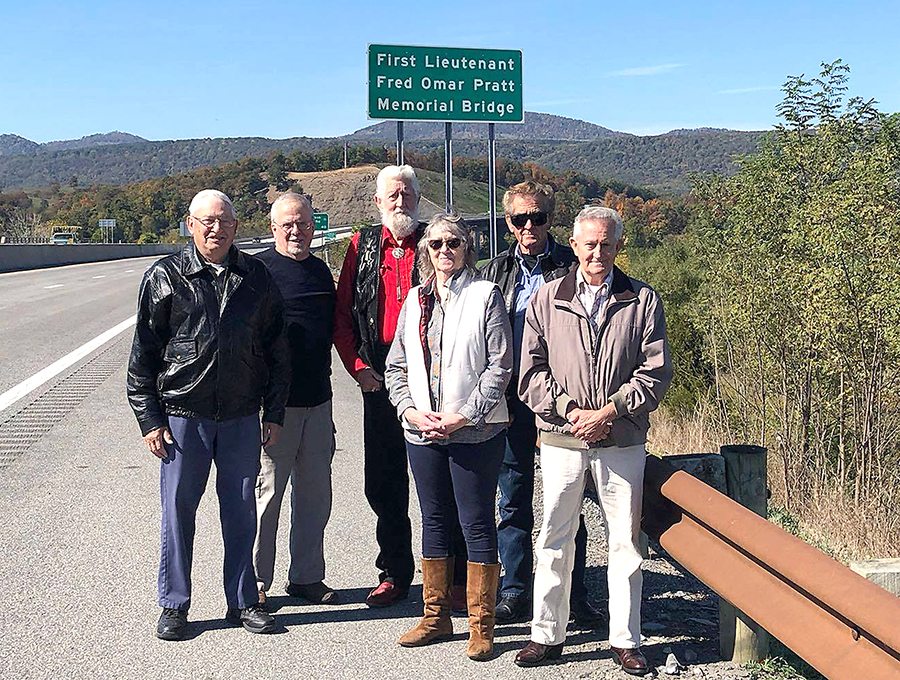Gilbert Terry remembers flying alongside First Lieutenant Fred Omar Pratt on Aug. 23, 1968 in support of a Green Beret unit on the ground near Duc Lop, South Vietnam. Enemy forces hit their “C”-model UH-1 Huey gun ship with anti-aircraft fire, striking key components and cutting the engine.
“Then, in the calmest voice you can imagine, Fred looked at me and said, ‘Well, there goes the engine,’” Terry said, recalling his own response, as their helicopter dropped from 100 feet, was a little less calm.
Pratt, Terry, and their crew all made it back to base that day, alive, but injured badly enough that Pratt and Terry had to talk a flight surgeon into clearing them to fly again three days later.
“He didn’t have to be there,” Terry said.
Silver Star recipient Roger Champ emceed the dedication on Oct. 17 at Moorefield’s VFW Post 9606. Those in attendance included Delegate Isaac Sponaugle, State Senator Randy Smith, County Commissioner David Workman, and JoBeth Delawder, representing U.S. Senator Joe Manchin.
The structure now named the First Lieutenant Fred Omar Pratt Memorial Bridge carries Corridor H/U.S. 48 over U.S. route 220, just north of Sheetz and McDonalds in Moorefield.
Pratt was born Aug. 17, 1941, the son of Edwin M. and Vern Hose Pratt. He enlisted in the Army in Oct. 1958, and served in Japan, Korea, and Vietnam. A Ranger and distinguished graduate of the Airborne School, he volunteered for Special Forces in 1962. He earned the Green Beret and his commission as an officer, completed Rotary Wing flight training, and returned to Vietnam in June 1968, assigned to the 155th Assault Helicopter Company.
On Aug. 23, Pratt was injured, but refused treatment until his crew was safe. He tended to his seriously injured crew chief, and exposed himself to enemy fire to summon aid for his crew.
On Aug. 26, after North Vietnamese forces captured half of the camp they’d been defending three days prior, Pratt convinced the flight surgeon and his chain of command to let him fly.
Per W.Va. House Concurrent Resolution 67, “Upon arrival in the area of aggression, Pratt took actions against a large enemy force, drawing heavy fire. During this engagement, he was fatally wounded.”
Pratt’s co-pilot landed the aircraft. Terry and his co-pilot that day were flying the wing position behind Pratt’s aircraft. Terry remembered glancing over his shoulder to see his gunner and crew chief throwing out anything constituting ‘extra’ weight. Even though neither Terry or his co-pilot said so out loud, the crew knew they were going in to get Pratt, and take him back to base.
Pratt’s co-pilot was able to get the heavily-damaged aircraft back to base.
Posthumously, Pratt received the Silver Star for gallantry in action; the Distinguished Flying Cross for heroism; the Air Medal with seven Oak Leaf Clusters; and the Purple Heart (two awards).
In June 1974, the U.S. Army named Building 4901, the Flight Simulator Building, at the Aviation School on Fort Rucker, “Pratt Hall.”
Pratt was married, with three young sons.
Sponaugle closed his remarks by commenting that people die three times: the moment of death; the moment the body is consecrated to its grave; and the last time the person’s name is spoken. By dedicating this bridge to Pratt, Sponaugle said citizens will speak Pratt’s name for generations.
Additionally, with the next bridge to the west named for Richard Lee “Dickie” Moyers, and the ramp to the east named for Captain William H. Denney, all of Moorefield’s Vietnam War dead will be remembered indefinitely.
“They’re still here,”Champ said.
Editor’s Note: Barbara, Pratt’s widow, was unable to attend the ceremony for health reasons. She died early Oct. 18. We hold Omar and Barbara’s loved ones in our hearts, thoughts, and prayers.

